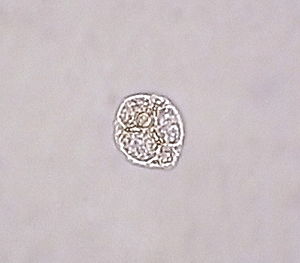Ebriacea
| Ebriacea | ||||||||||||
|---|---|---|---|---|---|---|---|---|---|---|---|---|

|
||||||||||||
| Systematics | ||||||||||||
|
||||||||||||
| Scientific name | ||||||||||||
| Ebriacea | ||||||||||||
| Lemmermann , 1901 |
The Ebriacea are a small group of heterotrophic flagellates consisting of only two planktonic species found in the sea. Their systematic position was unclear for a long time, today they are placed among the Cercozoa .
features
The representatives are unicellular, swimming flagellates. The two flagella are applied subapically. They have an internal, solid skeleton made of branched or perforated silicate rods. The cells are naked, so they do not have an outer cell wall. In one study, however, a layer of fibrillar material outside the cell membrane was observed.
Your cell nucleus is large and has a conspicuous nucleolus , the chromosomes are also condensed in the interphase.
Spread and nutrition
The Ebriacea occur worldwide in the coastal marine plankton. They usually only occur in low densities. While Ebria occurs in cold to temperate waters, Hermesium is found in warm waters. They feed phagotrophically on phytoplankton . The type of food intake is unknown, the lack of a cell mouth suggests food intake by pseudopodia , the presence of which, however, has not been conclusively proven.
Systematics
The systematic position of the Ebriacea was long unclear. In the 20th century they were assigned under various names to the Silicoflagellatae, Dinoflagellata, Sarcomastigophora, Opalozoa and Neomonada. In the systematics of eukaryotes by Adl et al. In 2005 they were listed as incertae sedis within the eukaryotes. Molecular genetic studies on Ebria tripartita in 2006 showed that the group belongs to the Cercozoa . Here, together with several uncultivated specimens, they are the sister group of the Cryomonadida .
The Ebriacea currently consist of only two established species:
The group has been known for fossil fuels since the Cretaceous , and they reached their greatest diversity in the Miocene .
supporting documents
- Sina M. Adl et al .: The New Higher Level Classification of Eukaryotes with Emphasis on the Taxonomy of Protists. The Journal of Eukaryotic Microbiology, Vol. 52, 2005, pp. 399-451. doi : 10.1111 / j.1550-7408.2005.00053.x .
- Mona Hoppenrath, Brian S. Leander: Ebriid Phylogeny and the Expansion of the Cercozoa . Protist, Volume 157, 2006, pp. 279-290, doi : 10.1016 / j.protis.2006.03.002 .